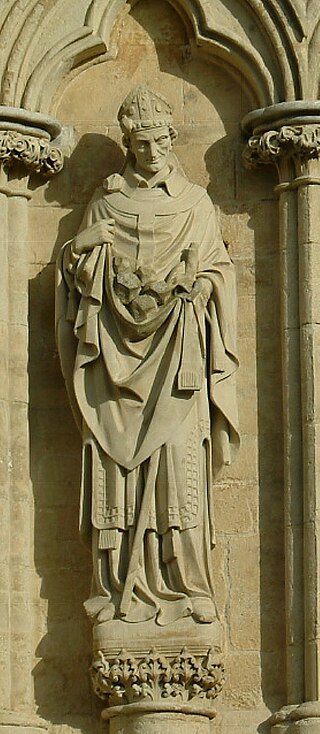
Ælfheah, more commonly known today as Alphege, was an Anglo-Saxon Bishop of Winchester, later Archbishop of Canterbury. He became an anchorite before being elected abbot of Bath Abbey. His reputation for piety and sanctity led to his promotion to the episcopate and, eventually, to his becoming archbishop. Ælfheah furthered the cult of Dunstan and also encouraged learning. He was captured by Viking raiders in 1011 during the siege of Canterbury and killed by them the following year after refusing to allow himself to be ransomed. Ælfheah was canonised as a saint in 1078. Thomas Becket, a later Archbishop of Canterbury, prayed to him just before his own murder in Canterbury Cathedral in 1170.

The Croyland Chronicle, also called Crowland Chronicle, is an important primary source for English medieval history, particularly the late 15th century. It is named for its place of origin, the Benedictine Abbey of Croyland or Crowland, in Lincolnshire, England. It was formerly also known as the Chronicle of Ingulf or Ingulphus after its supposed original compiler, the 11th-century abbot Ingulf. As that section of the text is now known to have been a later forgery, its author is instead known as Pseudo-Ingulf. The validity of the source itself has been questioned, partially due to the unknown identity of the original author, and gaps in all continuations of the text. There has also been substantially little effort made to find and translate the original manuscript.
Tancred or Tankred is a masculine given name of Germanic origin that comes from thank- (thought) and -rath (counsel), meaning "well-thought advice". It was used in the High Middle Ages mainly by the Normans and especially associated with the Hauteville family in Italy. It is rare today as a first name, but still common as a Norman surname: Tanqueray, Tanquerey, Tanqueret. Its Italian form is Tancredi and in Latin it is Tancredus. Its Italian patronymic is also Tancredi.
Wigstan, also known as Saint Wystan, was the son of Wigmund of Mercia and Ælfflæd, daughter of King Ceolwulf I of Mercia.

Botolph of Thorney was an English abbot and saint. He is regarded as the patron saint of boundaries, and by extension, of trade and travel, as well as various aspects of farming. His feast day is celebrated either on 17 June (England) or 25 June (Scotland).
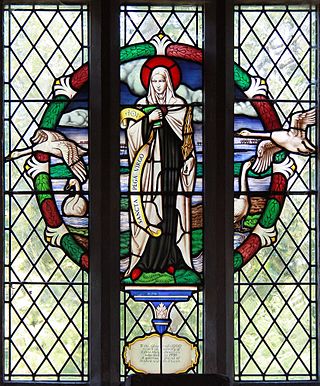
Pega is a Christian saint who was an anchoress in the ancient Anglo-Saxon kingdom of Mercia, and the sister of St Guthlac.

Ingulf was the Benedictine abbot of Crowland from 1087.

Crowland Abbey is a Church of England parish church, formerly part of a Benedictine abbey church, in Crowland in the English county of Lincolnshire. It is a Grade I listed building.
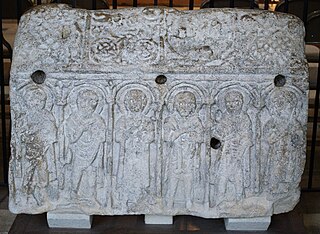
Medeshamstede was the name of Peterborough in the Anglo-Saxon period. It was the site of a monastery founded around the middle of the 7th century, which was an important feature in the kingdom of Mercia from the outset. Little is known of its founder and first abbot, Sexwulf, though he was himself an important figure, and later became bishop of Mercia. Medeshamstede soon acquired a string of daughter churches, and was a centre for an Anglo-Saxon sculptural style.

Thorney Abbey, now the Church of St Mary and St Botolph, was a medieval monastic house established on the island of Thorney in The Fens of Cambridgeshire, England.

Thurcytel was abbot of Crowland and perhaps also of Bedford Abbey.
Saint Fremund, also known as Freomund, was a ninth-century saint, hermit and martyr in Anglo-Saxon England. He is venerated at both the village of Prescote in Oxfordshire, where he is patron saint, and at Dunstable Priory in Bedfordshire.
Saint Edith of Polesworth is an obscure Anglo-Saxon abbess associated with Polesworth (Warwickshire) and Tamworth (Staffordshire) in Mercia. Her historical identity and floruit are uncertain. Some late sources make her a daughter of King Edward the Elder, while other sources claim she is the daughter of Egbert of Wessex. Her feast day is 15 July.
Ælfgifu of Shaftesbury was the first wife of King Edmund I. She was Queen of the English from her marriage in around 939 until her death in 944. Ælfgifu and Edmund were the parents of two future English kings, Eadwig and Edgar. Like her mother Wynflaed, Ælfgifu had a close and special if unknown connection with the royal nunnery of Shaftesbury (Dorset), founded by King Alfred, where she was buried and soon revered as a saint. According to a pre-Conquest tradition from Winchester, her feast day is 18 May.
Tova is a given name, nickname and a surname. Notable people with this name include:
Ingulf was an 11th-century Benedictine abbot of Crowland (Croyland).

Florentius of Peterborough was a seventh-century saint and martyr.
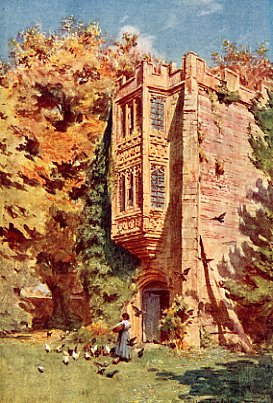
Eadwold of Cerne, also known as Eadwold of East Anglia, was a 9th-century hermit, East Anglian prince and patron saint of Cerne, Dorset, who lived as a hermit on a hill about four miles from Cerne. His feast day is 29 August.

Saint Huna of Thorney was a seventh century priest and hermit. His influence in the Northumbrian and Anglian courts make him an important figure in the Christianisation of Anglo-Saxon England.
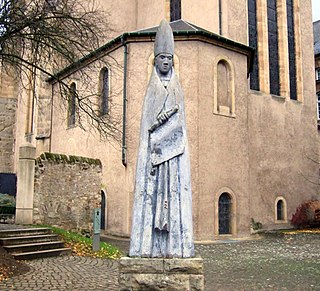
Wilgils of Ripon, also known as Wilgisl and Hilgis, was a seventh century saint and hermit of Anglo-Saxon England, who was the father of St Willibrord. His feast day is 31 January.










